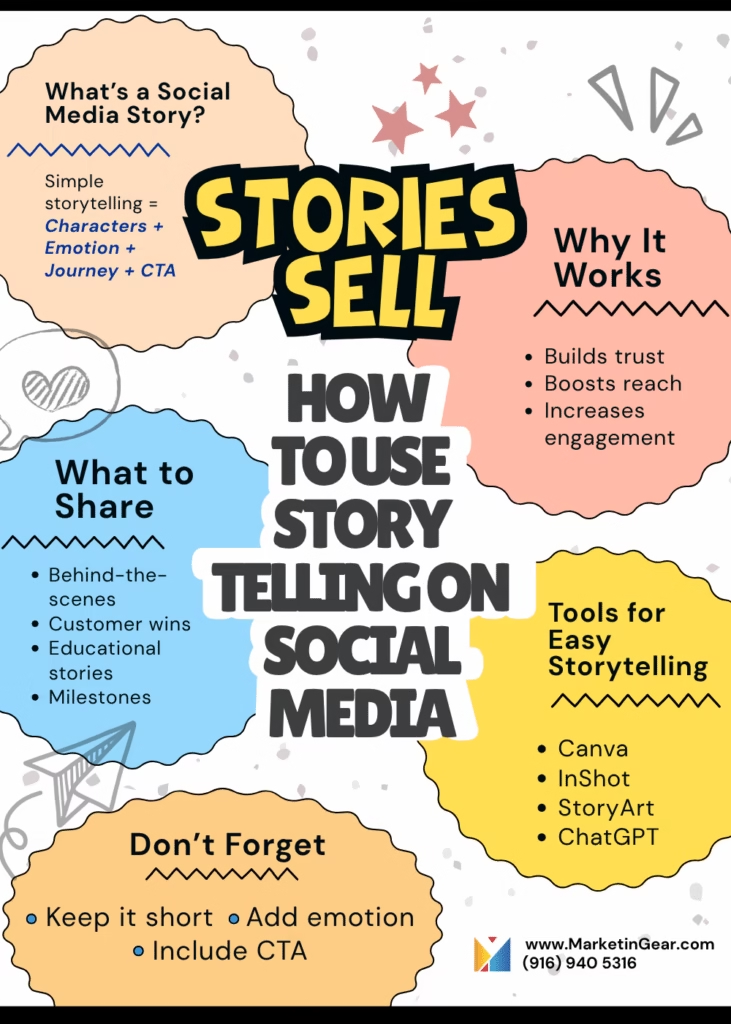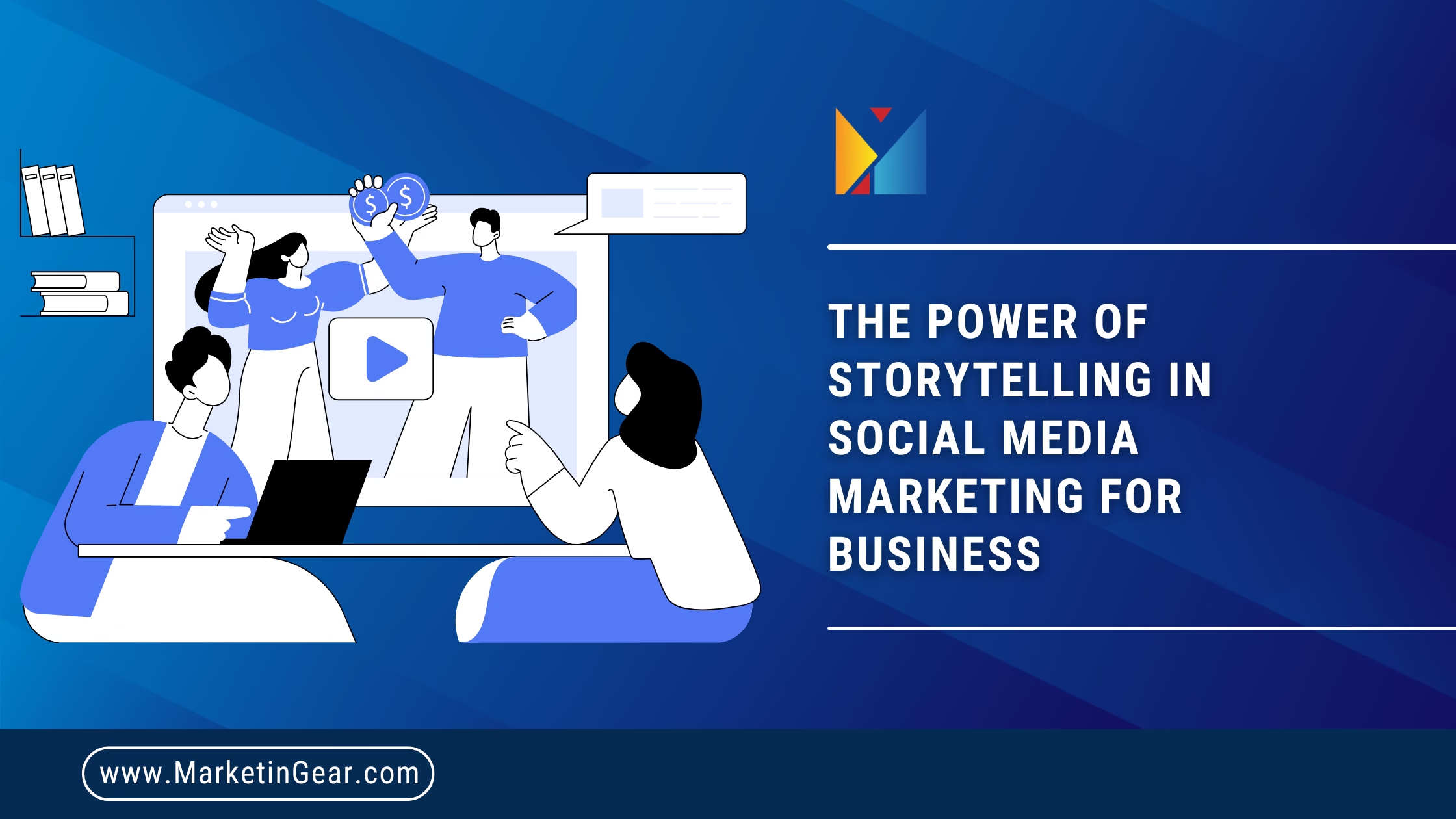Why Storytelling Wins Hearts (and Followers)
Picture this: You’re on your lunch break, thumb lazily swiping through Instagram. A glossy ad with bold text flashes—“50% OFF TODAY ONLY!” You barely blink before scrolling past.
Then, something different catches your eye: a 15-second video of a young woman, sitting at her kitchen table, carefully threading beads onto a string. Her voiceover shares how she started making jewelry to help pay her college tuition. You pause. You smile. You follow.
That is the power of storytelling.
In 2025, our digital feeds are overflowing with content—ads, promotions, announcements, memes. But what breaks through the noise and sticks in our memory? It’s not sales or specs. It’s stories. Human beings are wired to connect through narratives. We remember moments, not marketing copy.
For small businesses, that’s powerful news: your story is not a side note—it’s your strongest marketing tool.

1. What Is Storytelling in Social Media?
Social media storytelling is the art of expressing your brand’s identity, purpose, and values through relatable, emotionally resonant content. It goes beyond static product features or trendy hashtags—it’s about creating a connection.
Think of it as:
- Your brand’s heartbeat in a scroll-happy world.
- Less “Look at us!” and more “Let’s talk.”
- Creating an experience, not a transaction.
This type of storytelling can take many forms: videos, carousel posts, long captions, behind-the-scenes footage, even a thoughtful tweet. The format matters less than the authenticity and emotional hook behind it.
Key Elements of a Great Social Media Story
To create compelling content that resonates, make sure your story includes:
Relatable Characters
These could be you (the founder), your team, your customers—or even your dog mascot. People connect with people.
Clear Emotion
Joy, frustration, hope, humor—your story should make your audience feel something. That emotional pull is what keeps them watching.
Conflict or Challenge
Good stories involve struggle. Highlight obstacles you’ve faced—customers love the underdog journey.
Resolution or Transformation
What changed? How did you grow or solve a problem? This gives your story meaning and direction.
“Your story isn’t about perfection. It’s about connection.”
2. Why Storytelling Works on Social Media
Let’s break down exactly why storytelling works so powerfully in the social media space:
It’s Emotional
We don’t bond with logos. We bond with emotion—the joy of a win, the pain of rejection, the excitement of a first sale. When your story taps into shared human experiences, it builds real connection.
It Boosts Engagement
According to HubSpot (2024), storytelling content earns 3x more engagement than promotional posts. Why? Because it’s shareable, memorable, and people want to talk about it.
It Builds Trust
Your audience wants transparency. Sharing the human side of your business—your mission, values, team, and even your missteps—makes you more relatable and trustworthy.
It Increases Reach
When people relate to a story, they’re more likely to share it. This amplifies your reach organically—no paid ads required.
3. Types of Stories Small Businesses Should Tell
Not sure where to start? The truth is, you already have stories. They’re hidden in everyday moments. Here are five types you can start sharing today:
Founder’s Story
This is your origin tale—your “why.” Share what inspired you to start your business.
“After getting laid off in 2020, I turned to my childhood love for painting—and now, here we are, with over 10,000 orders shipped.”
Behind-the-Scenes
Show what it’s really like to run your business. Messy packaging days, early mornings, coffee spills—it all builds credibility and relatability.
Try a sped-up reel of your team prepping for a big launch or holiday rush.
Customer Stories
Let your customers speak for you. Ask them to share how your product or service made a difference.
“This planner helped me finally organize my freelancing schedule after 3 years of burnout.”
Educational Stories
Teach something, but make it narrative-driven. Don’t just drop tips—tell what happened.
“We tested five different hashtags for a local bakery. Here’s what happened after one month…”
Milestones & Celebrations
Hit a major goal? Launched something new? Share the joy.
“We just hit 1,000 orders! To celebrate, here’s a flashback to our very first one…”
4. How to Craft a Social Media Story That Converts
Telling a story is one thing—telling a story that inspires action is another. Follow this five-step blueprint:
Step 1: Know Your Audience
Who are they? What motivates them? What challenges do they face? When you understand your audience, you can create content that speaks directly to their hearts.
Step 2: Start With a Hook
Grab attention in the first 1–2 seconds. Use curiosity, contrast, or emotion.
“I had $48 left in my account when I launched my website…”
Step 3: Show the Journey
Take your audience along for the ride. Use visuals, emojis, voiceovers, and music to create a full sensory experience.
Step 4: Deliver the Message
Tie the story back to your product or brand mission—but subtly. Let the lesson or transformation be the focus.
“This wasn’t just about baking cookies. It was about reclaiming my time as a single parent.”
Step 5: End With a CTA
Always guide your audience to what’s next:
- Comment below
- DM for more
- Click the link in bio
- Tag a friend
5. Best Platforms for Social Storytelling (And How to Use Them)
Each social media platform has its own tone and format. Adapt your story to fit each one:
Instagram Stories & Reels
- Use quick cuts, captions, and trending audio
- Add interaction: polls, questions, sliders
- Archive great stories in “Highlights”
TikTok
- Hook viewers in the first 2 seconds
- Use trending sounds or memes
- Be real, be funny, be vulnerable
- Share business insights, leadership growth, and company wins
- Use clear, concise language
- Frame your posts as lessons learned, not bragging
- Great for longer posts, community-based storytelling, or emotional appeals
- FB Lives or photo carousels help you go deeper
- Ideal for local businesses and fundraisers
6. Tools to Help You Tell Better Stories
You don’t need a production team to create amazing content. These tools help you stay scrappy:
🛠️ Must-Have Tools:
- Canva – For branded templates, carousels, and visual storytelling
- InShot – Simple video editor for Reels and TikToks
- StoryArt – Stylish IG story templates
- HypeType – Add animated text for impact
- CapCut – For effects, voiceovers, and editing transitions
- ChatGPT – To help write captions, prompts, headlines, or brainstorm content ideas
7. Storytelling Mistakes to Avoid
Even the best stories can fall flat if you miss the mark. Avoid these common pitfalls:
- Talking only about the product—focus on people and emotion
- Being too vague—specificity creates authenticity
- Overediting—imperfection is relatable
- No subtitles—85% watch without sound
- Forgetting CTAs—don’t leave your audience hanging
8. Real-Life Mini Case Study: Pet Boutique Storytelling Win
Client: Local Pet Boutique in Sacramento
Problem: Struggling to gain local awareness and foot traffic
Solution: Weekly “Pet Hero Stories” featuring customer pets, highlighting their rescue stories and favorite treats
Execution: Reels on Instagram, story posts on Facebook, branded hashtag campaign (#SacPetHeroes)
Results:
- 230% rise in engagement
- Featured in local news
- Doubled in-store traffic in just 3 months
✨ Final Thoughts: Your Brand Deserves to Be Heard
You don’t need a big budget or a marketing agency to tell a compelling story. You just need honesty, emotion, and consistency.
In a sea of promotional content, real stories stand out. They sell without selling—because they inspire, move, and connect.
🎤 So go ahead: Press record. Write that heartfelt post. Share the messy behind-the-scenes.
Because your story? It might just be the one someone needs to hear.




